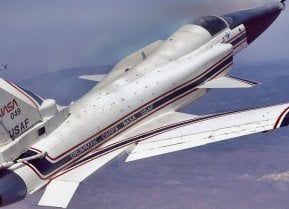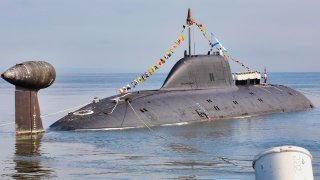Alfa-Class: The Russian Titanium Submarine the U.S. Navy Hated
In 1971, the Soviets unveiled their Project 705 Lira submarine (NATO reporting name Alfa-Class). Project 705 was a nuclear-powered attack submarine notable for two things: the use of a titanium hull, and for being one of the fastest military submarines ever built.
Meet the Alfa-Class Submarine: The modern submarine is a sophisticated machine that must meet demanding mechanical specifications. The specifications are demanding because the mission profile is somewhat unnatural.
Submarines must host a crew of sailors at, and beneath, the sea for extended periods of time.
While at sea, the submarine is often tasked with clandestine and highly sensitive operations. And always, the submarine must have the capacity to hone its various weapons systems (including nuclear) on land and/or marine-based targets. Accordingly, the mechanical specifications imposed on submarines are demanding.
Naturally, submarine manufacturers have spent the last century innovating, pushing for technological advancements, and trying to improve their machines and their war-fighting capacity.
Incentive to Innovate
In the 1970s, the Soviet Union was locked in a global Cold War with the United States. The two countries raced to create and field more advanced weaponry than each other. The most apparent venue for the tech race between the two Cold War powers was of course in space. Known as The Space Race, competition to be the first fueled intense tech development – culminating in America’s Apollo program and men walking on the moon.
But the Cold War competition raged simultaneously in other, less visible venues. Aerospace development, for example, where Soviet manufacturers like Mikoyan and Sukhoi raced American manufacturers like Boeing and Lockheed to field the most advanced fourth-generation, and later fifth-generation, fighters. The competition also extended to tanks. Intercontinental ballistic missiles. Aircraft carriers. And submarines.
To gain some sort of edge on the Americans, the Soviets experimented and pushed. The result, in one instance, was rather novel: building a submarine hull from titanium.
Titanium Hull Alfa-Class
In 1971, the Soviets unveiled their Project 705 Lira submarine (NATO reporting name Alfa). Project 705 was a nuclear-powered attack submarine notable for two things: the use of a titanium hull, and for being one of the fastest military submarines ever built. I
In fact, the Alfa-Class was second in speed to only one other submarine model, a Soviet prototype known as K-222.
The Project 705 Lira marked the first time that titanium was used in the hull design of a submarine. Titanium is a chemical element that can be reduced to produce a lustrous transition metal with valuable properties: low density, high strength, and resistance to sea water. Understandably, given titanium’s properties, the Soviets were keen to experiment with the material in their submarine design.
While the Project 705 did not sail until 1971, the idea was first proposed in 1957. The project was conceptualized to meet a set of demanding requirements (in the name of competing with American submarine design).
The requirements held that the new submarine must have sufficient speed to be able tp pursue any ship; the capability to evade anti-submarine weapons; the ability to succeed in underwater combat; low detectability; minimal displacement; and as small a crew as possible.
To meet the array of proposed requirements, a titanium alloy hull was selected. The idea is that a titanium hull would allow for low drag, low weight, and as a result, high speeds and deep dives. The design was meant to serve as an interceptor, which would stay in a harbor, or on a patrol route, and then race to meet an enemy as needed.
The Alfa-Class hull, like most Soviet nuclear submarines, was constructed as a double hill. With the double hull design, the internal hull is built to withstand the water pressure imposed during deep dives, while the external hull protects the internal hull and provides a more ideal hydrodynamic shape.
The titanium hull, like so many novel technologies, proved difficult at first. The lightweight alloy was prone to cracking – and the first Project 705 submarine was decommissioned on account of hull cracking. But the Soviets were able to improve their metallurgy and welding technologies sufficiently to eliminate hull cracking on all future Project 705 submarines.
To propel the titanium-hulled Project 705, a lead-bismuth cooled beryllium-moderated reactor was installed. The liquid metal cooled reactor had several advantages including: higher energy efficiency; did not need to be refueled – ever; lighter and smaller than water-cooled reactors. The lead-bismuth cooled reactor, and its weight and energy advantages, was a conceptual fit with the titanium hull – both were geared towards making a smaller, faster vessel.
The finished product was a submarine measuring 81 meters in length, with a 9.5-meter beam, and a 7.6-meter draft. The Project 705 displaced 2,300 tons when surfaced, and 3,200 tons when submerged. The submarine could operate regularly at depths of 350 meters, with a crush depth of about 1,300 meters. Most impressively, the Project 705 could achieve speeds in excess of 40 knots – all while carrying a complement of torpedoes, and/or cruise missiles, and/or mines.
In all, seven Project 705 Alfa-Class submarines were commissioned, one of which remained in service until 1996.
About the Author
Harrison Kass is a prolific defense write with over 1,000 pieces published. An attorney, pilot, guitarist, and minor pro hockey player, Harrison joined the US Air Force as a Pilot Trainee but was medically discharged. Harrison holds a BA from Lake Forest College, a JD from the University of Oregon, and an MA from New York University. Harrison listens to Dokken.
All images are Creative Commons. Image is of a Akula-Class sub.


